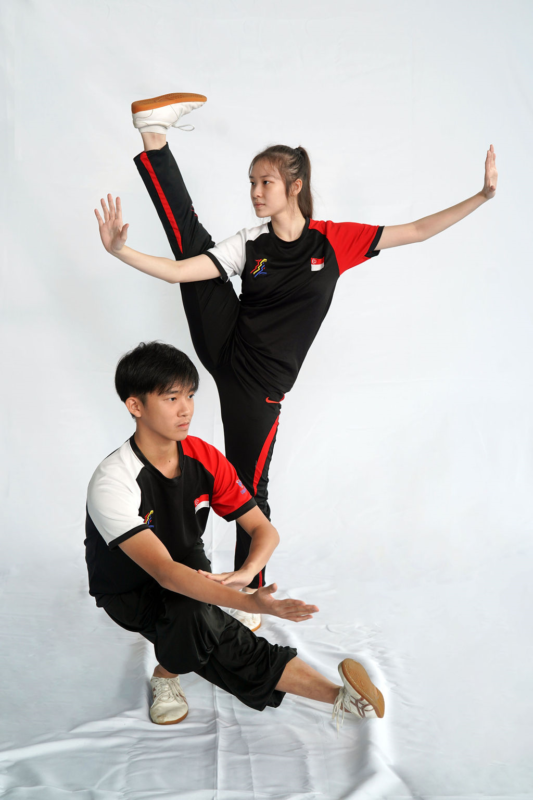Taijiquan
Taijiquan
Taijiquan is an internal Chinese martial art. There are different styles of Taijiquan, the most popular and wide-spread are the following five styles: Chen (陈), Yang (杨), Wu (武), Wu (吴), and Sun (孙) styles. Different styles of Taijiquan stress different aspects, but basically, they are all based on a similar system which features continuous circular and fluent movements.
Although different in style and form, all Taijiquan routines require their practitioners to be tranquil, calm, relaxed but concentrative. Practitioners are required to breathe regulatory and smoothly. The movements are executed slowly, continuously and softly, but hardness is implied in softness. There is a clear distinction between the empty and the solid, and between the above and the below in every movement. Motion and stillness exist together. The inner strengths and energy should be exuded through external movements and actions. This is why the play of the Taijiquan changes constantly and continuously like the moving clouds and flowing water.
Taiji for health and enjoyment can be practiced in any style of Taiji, performed at any level of physical prowess, as compared to competition Taiji which strives for perfection.
<< Chen Style Taijiquan >>
The Chen-style Taijiquan falls into two categories -the old and new frames. The old frame had seven routines, after many years, it has evolved to become Chen-style first and second routines. There are two routines for the new frame. The Chen-style Taijiquan is the oldest form, all the other styles of Tai Chi Quan having derived from it either directly or indirectly. With jumps, leaps and explosions of strength, the performance followed a circular path.
<< Yang Style Taijiquan >>
The originator of the Yang style Taijiquan was Yang Luchan (1800-1873) from Hebei Province. Yang went to learn Taijiquan from Chen Changxing in the Chenjia Valley as a boy. When he grew up, he returned to his native town to teach the art. To suit the needs of common people, Yang Luchan made some changes, and dropped some highly difficult moves, such as force irritating, broad jumps and foot thumping. His son shortened the routine which was further simplified by his grandson. The grandson’s form of the Yang-style Taijiquan was later taken as the protocol of the Yang-style Chuan.
Because of its comfortable postures, simplicity and practicability, this form has become the most popular routine for exercise and practise.
The Yang-style Tai Chi Chuan features agreeable movements and actions combining hardness, softness and naturalness. The Yang Style Tai Chi Chuan was known by the name “Da Jia” (“big frame”).
<< Wu Style Taijiquan >>
Wu-style Taijiquan was created by Quan You (1834-1902), a Manchu nationality who lived at Daxing in Hebei Province. He learned Taijiquan from Yang Luchan and later followed Yang’s second son Yang Banhou to study the “Xiao Jia Zi” small frame”). Quan You was known for his ability to soften his movements. Quan’s son Wu Jianquan changed his family name to Wu as he was brought up as a Han national. Wu Jianquan (1870-1942) inherited and disseminated a style of Taiji which is comfortable and upright. His style is continuous and ingenious and because his routine does not require jumps and leaps, it spread far and wide among common people. Since this style of Tai Chi Quan was disseminated by the Wu family, it became known as the Wu-style Taijiquan.
<< Wu Yuxiang Style Taijiquan >>
Wu Yuxiang (1812-1880) was the creator of another Wu-Style Taijiquan. A Yongnian resident in Hebei, Wu Yuxiang learned the basics of Taijiquan from fellow provincial Yang Lochan. Later, he also learned the new routine of Taijiquan from Chen Qingping and mastered it and eventually developed his own style. The Wu Yuxiang style of Taiji features compactness, slow movement, strict footwork and distinguishes between substantialness and insubstantiality. The chest and abdomen are kept upright while the body is moving around. The hand never goes farther than the foot. The two hands are in charge of their respective halves of the body-one does not infringe upon the other.
<< Sun Style Taijiquan >>
The initiator of the Sun-style Taijiquan was Sun Lutang (1861-1932) from Dingxian County in Hebei Province. Sun was a master of Xingyiquan and Bagua Zhang. In 1910s, he followed Hao Weizhen to learn Taijiquan. He later created the Sun style of Taijiquan by blending the cream of the styles of Taijiquan, Xingyiquan and Baguazhang. The features of the Sun-style Taiji is that practitioners advance or retreat freely with quick and dexterous movements, which are connected with each other either in closing or opening stances when the direction is changed.

